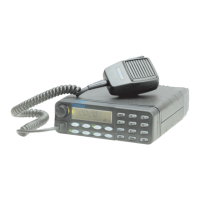27
Making a Call to a Radio In Diversion Mode
Your T2020
II
can be programmed to respond to a diversion status report when making a call. When it
detects the diversion status in the acknowledge from the radio it has called, it displays ‘DIVERT’, to
indicate that the call has been diverted. It then proceeds to switch to the programmed diversion chan-
nel.
Emergency Operation (Selcall Option Fitted)
Your T2020
II
can be set to make emergency calls to a preprogrammed party (usually your base or
your despatcher). To use this capability, the radio must be fitted with the Selcall option, and be con-
nected to a hidden emergency switch. Alternatively, the Auxiliary (
) key on the control head may
be preprogrammed to send an emergency call.
1. To send an emergency call, operate the hidden switch, or press the Auxiliary (
) key. There
is no change in the T2020
II
control head indicators, but the radio sends a Selcall emergency
code to the preprogrammed party every few seconds, until it receives an acknowledging Selcall
code.
Note:
The emergency cycling option is controlled at the time of programming. If emergency cycling
is disabled, then the emergency sequence is sent only once, and no transmit/receive cycling
occurs.
2. The radio then adopts a transmit/receive cycle, which allows the base or despatcher to monitor
activity in the vicinity of the radio.
The radio can be removed from this mode either by receiving a reset code from the base or despatcher,
during one of its receive periods, or by turning the radio off and back on, without operating the emer-
gency switch.
A trailing alarm tone can be sent with the emergency sequence, if the alarm tone was enabled when the
radio was programmed.
Other Selcall Features
Your T2020
II
may be programmed with other Selcall functions. Consult your Tait dealer for more infor-
mation on the following functions:
●
Quiet Status Interrogation (QSI)
●
Automatic Numbering Identification (ANI)
●
Stun
●
Deferred Calling
●
Cancel call indicators on remote reset

